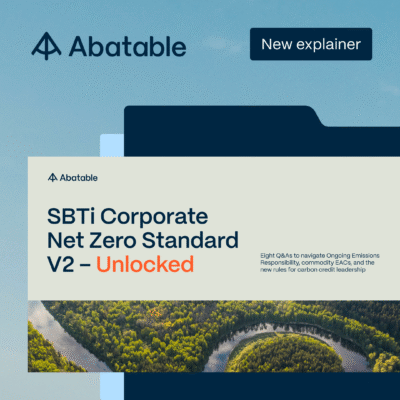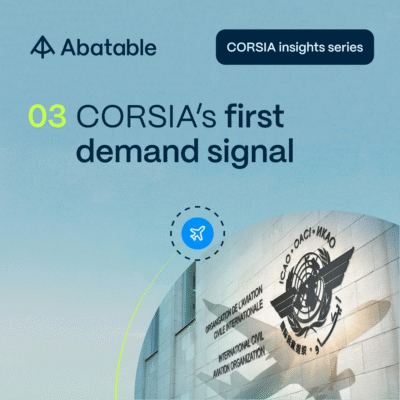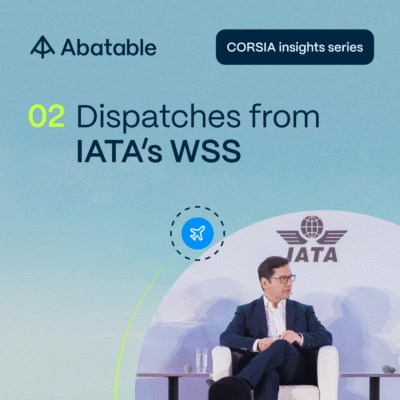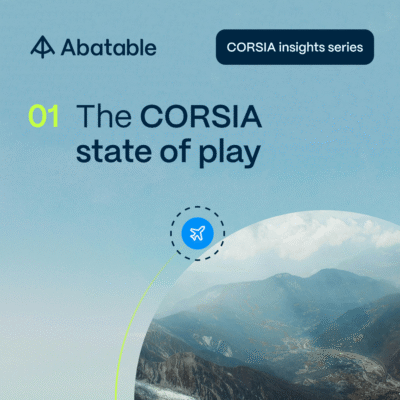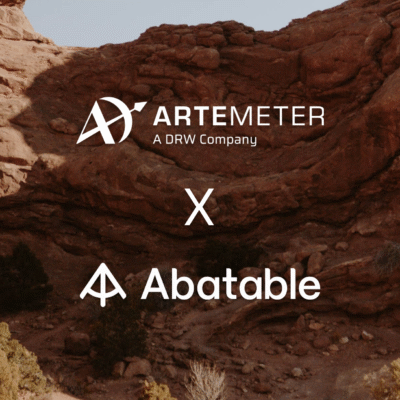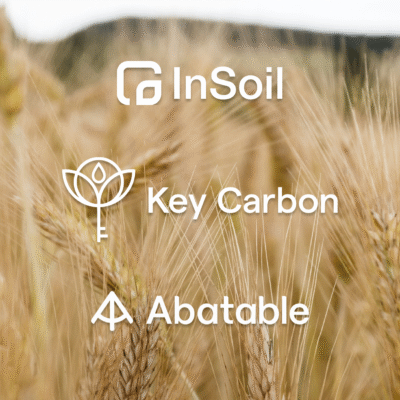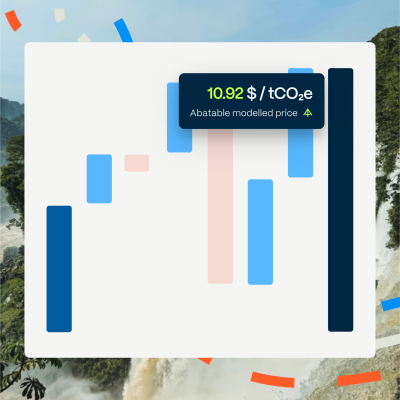Contents
- Overview
- Forecasted supply pipeline methodology
- Forecasted CORSIA status methodology
- Forecasted CCP likelihood methodology
- Forecasted Article 6 corresponding adjustment methodology
Overview
The primary objective of this explainer is to provide a comprehensive description and critical evaluation of Abatable’s recent advancements in supply forecasting. Specifically, we aim to analyse the intricate interplays between initiatives such as CORSIA (the Carbon Offsetting and Reduction Scheme for International Aviation), the Core Carbon Principles (CCP), and Article 6 of the Paris Agreement.
Our supply model allows us to answer questions such as the following:
- How many credits are expected to be approved by the IC-VCM to receive a CCP label, or be eligible for CORSIA phase 1?
- From these projects, how many are expected to receive a Letter of Authorisation for corresponding adjustments?
- What is the geographical distribution of these credits?
Given the complexity and dynamic nature of market developments, we invite readers to engage critically with our methodologies and contribute to refining our forecasting models. For inquiries or contributions, please contact us here.
Forecasted supply pipeline methodology
To estimate future supply, we take all active projects in the five major carbon registries (VCS, Gold standard, ACR, CAR and ART) and build a supply pipeline until 2040 for each based on their crediting period dates and estimated annual issuance. We then aggregate these estimated issuances by year across all projects to obtain market-wide forecasted supply.
We add 100% of the estimated annual credits for fully verified projects to our pipeline without any discounting. We then use the following assumptions about the percentage of pre-issuance projects successfully getting verified and being allowed to issue, calling this the project’s conversion rate:
🖊️ Assumptions on conversion rates for pre-issuance projects
- Under development projects: 5% allowed to issue
- Under validation projects: 10%
- Validated projects: 40%
- Under verification projects: 70%
In the case of undisclosed project data, we make the following assumptions:
🖊️ Assumptions on backfilling undisclosed project data
- If the crediting end date of a project isn’t publicly available, we assume it will continue to operate until 2040.
- For projects without readily available annual reduction figures, we use the yearly average volume of their historical issuances.
We are developing plans to refine our model to reflect the supply potential of the market more accurately.
🖊️ In future iterations:
- We will factor in the time gap between the time greenhouse gases are reduced/removed and the time the credits of this vintage year are issued. This is because it takes time for third-party verification bodies to monitor on the ground and grant developers the right to issue. In our future iterations, we aim to visualise credit availability by vintage.
- We plan to enhance our model by forecasting volumes from projects yet to enter registries based on carbon funding announcements and the rate of project entry over time.
- We aim to incorporate forecasted issuances for the Global Carbon Council carbon credit program (conditionally approved for Phase I) in our next iteration.
- We will allow expiring projects to renew their crediting years. For example, a project with a crediting period end date in 2025 issuing X credits annually may renew its crediting period and keep issuing until 2030. At the moment, we assume the project stops operating and issuing after 2025.
Forecasted CORSIA status methodology
CORSIA is a compliance carbon pricing scheme for international aviation. Airlines with annual emissions over 10,000 tonnes of CO2 emissions must purchase credits to compensate for any emissions above their 2019 emissions level.
This year CORSIA has entered its first phase (2024-2026), which is technically voluntary but in reality is mandatory for flights between participating states (126 countries). Airlines don’t need to provide evidence of their compliance until 31 January 2028.
2027-2035 is the second phase which is mandatory for flights between almost all states (this will bring in China, India, Brazil and Russia – a substantial demand growth).
In late March, the International Civil Aviation Organisation’s (ICAO) announced it would only ‘conditionally’ approve three major standards for Phase 1 of CORSIA. This means major standards, including VCS, Gold Standard and CAR, remain under the status of conditional approval. For these registries, we make assumptions on project Phase 1 eligibility based on their methodology’s CORSIA pilot status.
🖊️ We make the following assumptions:
- If at least one VCS project operating under a specific methodology was granted pilot phase eligibility, we assume all active VCS projects under that methodology will be eligible for Phase I. The forecasted issuances of these projects will therefore fall under the CORSIA ‘Forecasted approval’ category in the model.
- If no historical VCS project operating under a specific methodology was granted pilot phase eligibility, we assume no VCS projects under that methodology will be eligible for Phase I. The forecasted issuances of these projects will therefore fall under the CORSIA ‘Forecasted rejection’ category.
- As ART and ACR projects have been granted Phase I eligibility with no methodology exclusion, the forecasted issuances of these projects will fall under the CORSIA ‘Approval’ category.
Forecasted CCP likelihood methodology
The Core Carbon Principles is a private sector-led initiative focused on ensuring high-integrity supply-side claims for the VCM. CCP labels, provided by the Integrity Council for the Voluntary Carbon Market (IC-VCM) are perceived as a valuable quality marking, assessed on a registry-methodology level. The IC-VCM fast-tracks CORSIA-eligible methodologies for CCP eligibility assessment.
CCP likelihoods are forecasted based on Analysis by Abatable across a range of methodologies submitted to the IC-VCM for assessments. For methodology details, see Abatable’s blog on CCP eligibility.
Forecasted Article 6 corresponding adjustment methodology
One of CORSIA’s requirements is for credits to be ‘correspondingly adjusted’, which means that they are adequately accounted for in national carbon budgets and climate pledges, or Nationally Determined Contributions (NDCs) under the Paris Agreement on climate change.
For a credit to be correspondingly adjusted, its developers must obtain a Letter of Authorisation (LoA) from the host country’s government. An LoA recognises the host country’s agreement to remove the credit from its own NDC accounting, by applying a corresponding adjustment to the credit. This allows it to be used towards another objective: for a buyer country’s NDC, for an international mitigation purpose such as CORSIA, or for other purposes including voluntary claims. An LoA is effectively the promise of a corresponding adjustment in the future.
To date, most countries do not have regulations that enshrine the governance, infrastructure, and processes to issue LoAs. To overcome this challenge, for our current version of the model, the Abatable policy team has manually inputted the countries that are likely to issue corresponding adjustments based on a low, medium, or high likelihood. This is based on extensive policy knowledge and Abatable’s policy assessment methodology.
In future iterations of our model, we aim to forecast the percentage of issuances likely to receive a LoA by country over time based on quantitative factors.
Any questions?
Contact us here.

